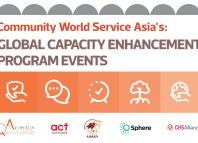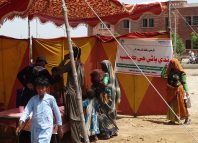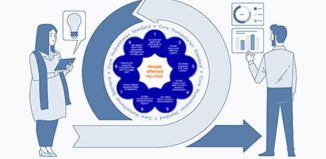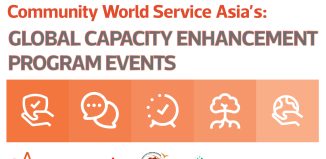Exploring ways to adapt safeguarding to wider and diverse cultural contexts
Photo Credit: www.unocha.org
As part of the 2020 Regional NGO Partnership Events[1], a webinar titled ‘Safeguarding: Know – Act – Apply’, was hosted and organised by Asian Disaster Risk Reduction Network’s (ADRRN) Quality and Accountability (Q&A) Hub and Community World Service Asia (CWSA). The webinar discussed on-going initiatives on community safeguarding and explored how safeguarding can be adapted more widely and to traditional contexts. It also built upon approaches of familiarizing communities on safeguarding policies and the humanitarian community’s accountability to them on the issue.

More than 250 humanitarian and development practitioners participated in this 90-minute webinar that shared a wide array of diverse expertise and knowledge from all over the world. Panelists, Smruti Patel, Founder and Co-Director of The Global Mentoring Initiatives (GMI) and Member of International Convening Committee of A4EP based in Switzerland; and Kjell Magne Heide, Complaints and Accountability Advisor at Norwegian Church Aid (NCA) based in Norway joined the session to share best practices on safeguarding.
Speaking about Protection against Sexual Exploitation and Abuse (PSEA), Ester Dross, lead facilitator and moderator of the webinar, shared, “We would like to look at safeguarding from a different angle, to give more weight to the P of Prevention. Safeguarding is a common task; a common goal and we all have a role during the travel to reach the final destination.”
What do you understand by safeguarding? Is this a policy? Is this about protection? Participants shared their views on what safeguarding mean to them during the webinar.
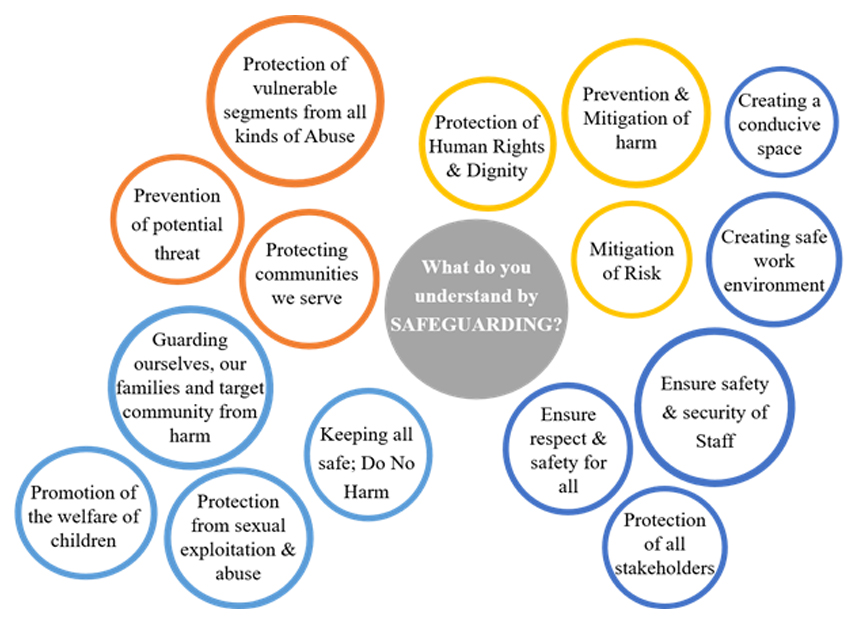
Safeguarding is a framework including a range of different policies, procedures and practices to protect vulnerable populations from any harm which can be provoked by the very existence of our work, including code of conduct safeguarding policy, child safeguarding, guidelines, good practice, HR manuals, and also establishing efficient Complaint Response Mechanisms.
Ester shared, “When we talk about a safeguarding framework we speak about protecting people from any harm that we as an organization potentially bring to them – harm as a result of power imbalance, linked to gender, to poverty, to any kind of different vulnerabilities, as much for children as for adults. Internally displaced, refugees and migrants are particularly exposed to safeguarding risks.”
Power imbalances bring us to Accountability!
When talking about Safeguarding measures, it is essential to acknowledge that most sexual exploitation or abuse has as an underlying reason – the power differential between humanitarian workers and the people we work with or for. The shortest definition of accountability is the responsible use of power.
“Safeguarding and accountability is about how we change those power dynamics, how we change our organisational culture into a more open, more equilibrated, more inclusive and more diverse work space where different voices can not only be heard but lead to choices for the people who are in the center of humanitarian aid. This also means that communities need to be better integrated and taken into account when we define our safeguarding strategies,” suggested Ester.
Power is about wealth, independence, ability to set standards, influence, independence, privilege, status and but also about knowledge. It is not easy to change quickly some of these factors; however, access to information and knowledge sharing contribute to have more power, therefore sharing information and knowledge are key, not so difficult to implement and the essential basis for equilibrating power imbalances and integrate communities fully into the accountability cycle, preventing exploitation and abuse.
While sharing some of her own experiences on witnessing issues of PSEA as an aid worker, Smruti shared,
“We need to work with partners to really think about safeguarding holistically. We have to learn how to create a culture inside and outside the organisation because unless we start inside with the staff you cannot permeate that culture outside of safeguarding.”
Identifying key steps and channels to discuss Safeguarding
Smruti highlighted steps that need to be taken to ensure a culture of safeguarding through key messages. According to her, it was vital to sit together with senior management teams and initiate a discussion on value. Citing her own experience, she said,
“Through consistent and meaningful dialogue, we laid out the policies and procedures in place and staff’s knowledge on that. We mapped the communications channels in the organisation to communicate the policies and code of conduct. For instance, as part of their communication strategy, a partner organisation based in Myanmar shared how they discussed such issues during their regular staff meetings held at project level on a quarterly and monthly basis. These are opportunities to communicate the orgainsation’s code of conduct and remind people constantly on adhering to these policies at every level of the organisation.”
Secondly, building the capacity of staff on effectively bringing PSEA to the communities is essential. Since the issue is a sensitive one, it needs to be done in a strategic way for which relevant staff should be trained.
“I encouraged the staff to talk about the values as part of code of conduct in terms of transferring the code of conduct to the communities we work with. We mapped out the target communities and communication channels in place in terms of programming. We looked at those channels and what key messages can be provided through them.”
The third step is to move in the communities. This involves identifying key focal persons from among the communities to engage with on enlightening the people about safeguarding.
“In the communities we visited, there were child protection focal points, some were working on women issues as gender activists and other were working on GBV[2]. We saw these platforms as a way to communicate the key messages on safeguarding. Additionally, we aimed at setting up a mechanism through which the community can approach us with their concerns. This holistic approach ensured engagement of people on the ground, people who are dealing with safeguarding issues and get their collective wisdom, establishing the right kind of communication system in place. When the feedback came in the organisation, the key messages were drafted on basis of that. The key inspiration are those six core principles of SEA.”
Smruti encouraged organisations to explore communication networks within the communities through which key messages can be communicated and clearly understood by the communities. The key messages have to be appropriate to men, women, girls and boys. Likewise, internal messaging is as important as external messaging. Working collaboratively with other organisations is vital in addition to understanding the internal culture of the organisation.
Meaningful dialogue with communities and stakeholders helps to build trust, which is another important pillar.
“To take PSEA forward through collaborations, building trust with communities and staff through open discussions is vital. Then we ACT. By acting on the complaints and feedback, we can show the trust. To maintain trust, you need to act,” added Smruti.
Investigations as a Preventive Tool for SEA
What are the core principles of conducting PSEA investigations?
How do we encourage people for to report?
How can we overcome rumors, especially about SEA?
Participants raised these questions in the webinar. While addressing these questions, Kjell Magne Heide talked about investigations on SEA,
“You need to know the expected behavior of people that work with you and you should know how you will be able to report it. Sadly, many people do not report it. And even if they do, they have expectations which sometimes might not be realistic. Like Smruti said, there has to be a culture, it should be built into you and not rely on documents always. However, in an investigation, one has to refer to documents and policies,” initiated Kjell in his discussion about investigations on SEA.
Trust has to be earned. “It takes years to build trust and it only takes a day to lose it. You have to be structured in order to build and maintain this trust. It is therefore essential to assign a system that fits in the context you are working in and it is crucial that you follow the procedures.”
“There are some limitations to investigations, especially now in the COVID-19 situation. Be honest about the limitations with the communities, so that the people you work with have the right expectations to maintain the trust. Be sure to treat with dignity and respect. It is easy for me an as investigator to judge complaints on basis of severity. For the person who registered the complaint, it is a serious concern and therefore, I have to treat all complaints with the same dignity and respect, independent of how I as an investigator judge the severity of the case.”
Kjell recalls a case in a country office, where one staff filed a complaint of SEA against another which was thoroughly investigated and the perpetrator was found guilty and was dismissed.
“There were more complaints filed in the same context from the same office. This shows that through vigilant and transparent investigations, we can demonstrate a reaction to the alleged perpetrator when we have enough evidence. This contributes building trust with others who then feel empowered to come forward with their own concerns.”
Kjell remarked however that it is difficult to conduct SEA investigations and while investigating one has to be true to themselves and the organisation.
Key Takeaways
- The Code of Conduct ensures that an organisation’s employees understand and accept legal and professional responsibilities of working in the organisation and to promote good practice and appropriate behavior among employees and promote the highest levels of ethical behavior
- Promotion of safeguarding within the organisation is key to cultural changes
- Media is an effective channel to raise awareness on safeguarding and to highlight expected and prohibited behaviors around the issue
- An allegation cannot be substantiated unless facts are substantiated with reasonable inference on the balance of probabilities through a transparent and active investigation process
- Thorough contextual research and integration of community voices is key to implementing safeguarding principles effectively in emergencies.
[1] collaborative events hosted collaboratively by Community World Service Asia (CWSA), Asian Disaster Reduction and Response Network (ADRRN), International Council of Voluntary Agencies (ICVA) and United Nations Office for the Coordination of Humanitarian Affairs (UNOCHA).
[2] Gender-based Violence


